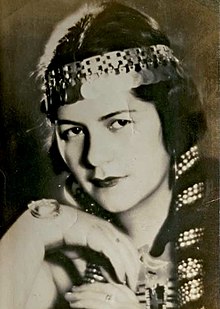Rayén Quitral
You can help expand this article with text translated from the corresponding article in Spanish. (March 2023) Click [show] for important translation instructions.
|
Rayén Quitral | |
|---|---|
 Quitral in 1938 | |
| Born | María Georgina Quitral Espinoza 7 November 1916 |
| Died | 20 October 1979 (aged 62) Santiago, Chile |
| Occupation(s) | Opera singer, actress |
| Years active | 1937-1967 |
María Georgina Quitral Espinoza, more commonly known as Rayén Quitral (7 November 1916 – 20 October 1979),[1][better source needed] was a Chilean soprano and stage actress of Mapuche and Picunche descent.[2] Known for her performance of the character of the "Queen of the Night" in the opera The Magic Flute, she was also known for regularly appearing in indigenous Mapuche dress, publicly displaying pride for her indigenous ancestry.[3]
Biography[edit]
Rayén Quitral was born in the village of Iloca, in the commune of Licantén within the province of Curicó, in the Maule Region. She studied singing in Chile, before debuting aged 21 at the Municipal Theatre of Santiago in 1937.[4] 4 years later, Quitral performed the role of the "Queen of the Night" in Mozart's opera The Magic Flute at the Colón Theatre of Buenos Aires in 1941. She went on to appear in multiple performances across the Americas, later residing for a long period in Mexico.[5]
Quitral performed in Lucia de Lammermoor in Chile in 1942, as well as playing the role of Gilda in Rigoletto in 1943. In 1950, she toured multiple concerts in Italy and France, as well as London, where she achieved great success in 1951, once more with a performance of The Magic Flute.[5] This acclaim led to her appearance in Buckingham Palace afterwards.[4]
In 1967, she retired aged 51 from touring, and dedicated herself to educating young people of limited means in singing[citation needed]. On 19 September 1972, the Chilean government awarded her a large pension.[6] Quitral died on 20 October 1979 in Santiago, Chile.[1]
References[edit]
- ^ a b "Rayén Quitral - Biografía". Musica Popular (in Spanish). Ministry of Culture (Chile) (authors of www.musicapopular.cl)). 2012. Archived from the original (PHP) on 16 April 2014. Retrieved 15 April 2014.
- ^ Garcés, Mario; Milos, Pedro; Pinto, Julio; Rojas, María Teresa (2000). "Memoria de las mapuches urbanas: entre la integración con discriminación y la organización con identidad" [Memory of the urban Mapuche: between integration and discrimination, organization and identity]. In Olguín, Myriam (ed.). Memoria para un nuevo siglo: Chile, miradas a la segunda mitad del siglo XX [Memory for a new century: Chile, views of the second half of the 20th century] (in Spanish). Compiled by Miguel Urrutia. Santiago, Chile: LOM Ediciones. p. 490. ISBN 978-956-282-222-0.
- ^ González, Juan Pablo & Claudio Rolle (2005). Historia social de la música popular en Chile (1890-1950) [Social history of popular music in Chile (1890-1950)] (1st ed.). Ediciones UC.
- ^ a b Muñoz, Manuel Peña (2001). Los cafés literarios en Chile [Literary Cafes in Chile] (in Spanish) (1st ed.). Chile: Archivo del Escritor. p. 219. ISBN 978-956-284-206-8.
- ^ a b "En Centro Cultural de Los Escalones fue lanzado libro sobre Rayén Quitral" [The Los Escalones Cultural Center has launched a book about Rayén Quitral]. La Prensa (in Spanish). 2009. Retrieved 11 March 2010.[dead link]
- ^ "Concede Pension, Por Gracia, A Doña Maria Georgina Quitral Spinoza" [Concession of Pension, by grace, to Doña Maria Georgina Quitral Spinoza]. Library of the National Congress of Chile (in Spanish). Library of Congress of Chile (published 9 October 1972). 29 September 1972. Retrieved 19 August 2014.
